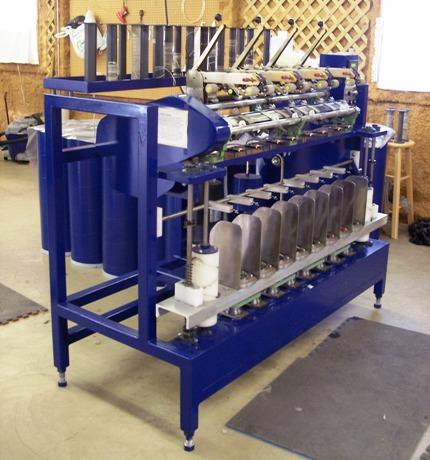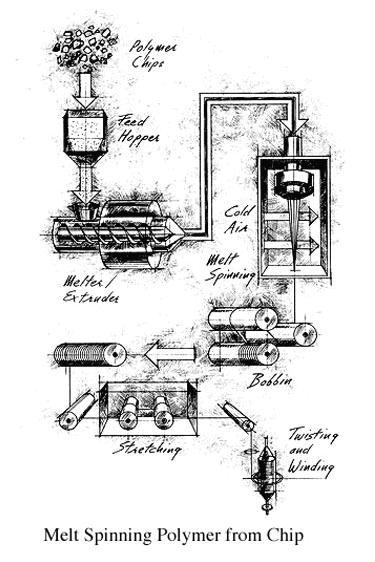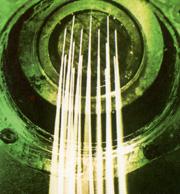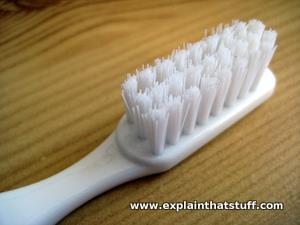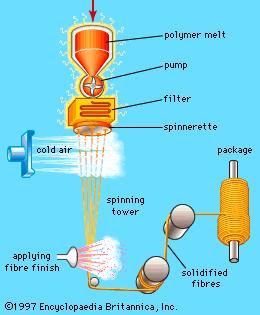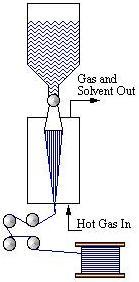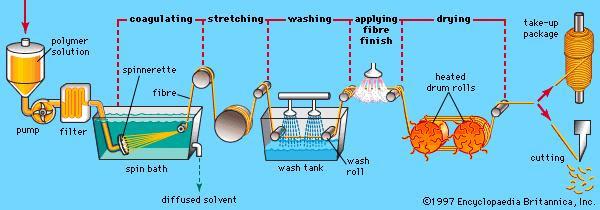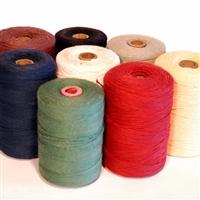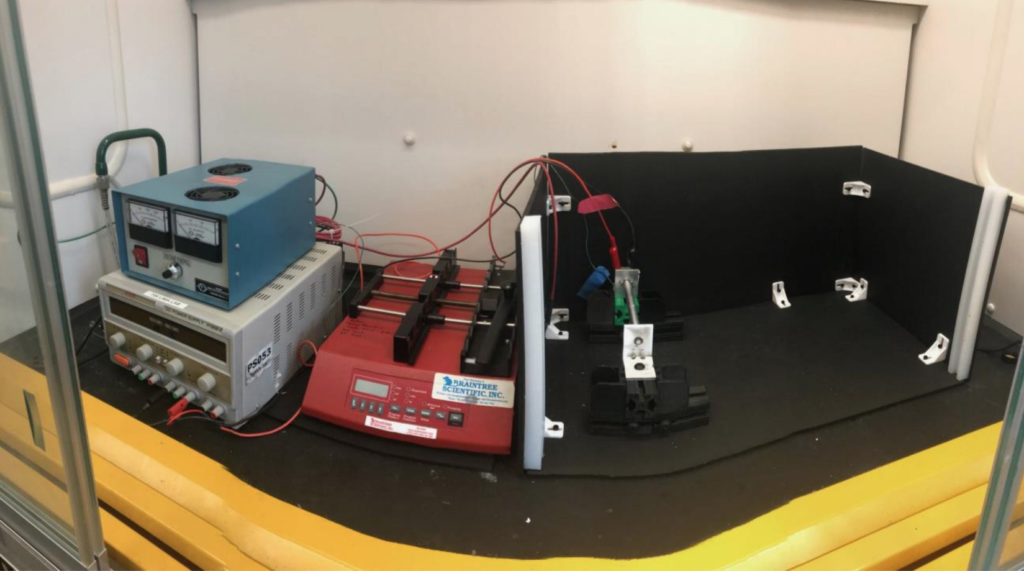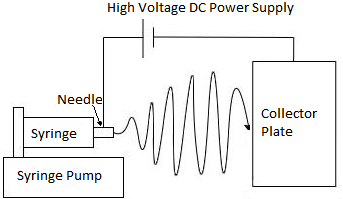Fiber spinning is used to make synthetic fibers for use in many industries. There are three main types of fiber spinning methods: melt, solution, and reaction spinning. In fiber spinning, a liquid polymer is extruded through small holes in a spinneret to form thin filaments, as shown below. Upon leaving the spinneret the filaments solidify. After solidification, filaments can be combined to make threads and/or drawn to change the filaments’ properties.
The processes governing the three types of fiber spinning differ mainly in the way the polymer is liquefied and solidified.
Polymer Product Manufacturing Steps
Fiber spinning is one of the ways you can process the polymer in the manufacture of polymer products:
Melt Spinning
General Information
Melt spinning is the most widely used form of fiber spinning. In melt spinning either molten polymer is used or polymer pellets are melted down. Once the filaments are extruded they are cooled in a fluid medium such as air, gas, or even water.
Equipment Design
In melt spinning, as shown below, the molten or melted polymer is pushed vertically downwards through the spinneret. When the filaments emerge from the spinneret they are cooled by a gas, usually air, which flows either perpendicularly across, currently, or countercurrent to the filaments.
The filaments can then be brought together and/or twisted together to form a thread. Before winding the thread on the bobbin, it is often treated with water or a wetting agent and then a lubricant. Later, the wound thread may be dyed and drawn on other machines.
Spinneret design, such as those shown below, is dependent on the type of spinning and desired cross-sectional shape of the filament. The cross-sectional shape determines different features the filament will exhibit, such as how it will reflect light, the ability to insulate, and how easily it shows dirt.
(Copyright American Fiber Manufacturers Association, Inc.)
Spin plates and spinnerets may have as many as 80,000 bores spaced less than one millimeter apart. Some spinnerets have superfine capillaries 50 micrometers in diameter. These tiny bores and capillaries are very sensitive to impurities and corrosion; this is one reason why spinnerets are often made of high-grade steel or other metals that can be easily cleaned.
Usage Examples
Some common fibers produced using melt spinning are polypropylene, polyester, and nylon which are shown below and to the right. Nylon was the world’s first synthetic fiber discovered and was initially used for toothbrush bristles before being used to produce women’s stockings during the 1940s.
Advantages
- Ability to run at high line speeds.
- Requires no solvent that must be recovered later.
Disadvantages
- Necessary high temperatures may damage some polymers.
Solution Spinning
Solution spinning is used when the desired polymer does not form a stable melt. These polymers are dissolved in a solution to liquefy them rather than melting them. The two main types of solution spinning are dry and wet spinning.
Dry Spinning
In dry spinning, the polymer is dissolved in a volatile solvent. Once dissolved, the polymer solution is extruded through the spinneret which is in an enclosed drying tower. The solution goes through a drying process in this tower, where the solvent is evaporated.
Equipment Design
The spinning solution is often filtered many times to remove foreign materials that might cause thread defects or clogging in the machine. The solution is extruded into the drying tower through which hot air or other gases pass. The concentration of the polymer increases as the solvent evaporates, leaving a solid polymer filament behind. The solvent is later recovered from the gas by condensation or absorption and is then recycled.
Solvent selection is very important and is based on boiling point, latent heat of vaporization, thermal stability, toxicity, and inertness. Non-polar solvents are often preferred because of their low boiling points and heat of vaporization. However, non-polar solvents are prone to build-ups of electrostatic charge, which can be very dangerous.
Advantages
- Better than melt spinning for temperature-sensitive polymers.
- Faster production rates than melt and wet spinning.
Disadvantages
- Solvent recovery is costly.
Wet Spinning
In wet spinning, the polymer is dissolved in a non-volatile solvent. The spinneret is located in a coagulating bath that causes the fiber to precipitate out.
Equipment Design
The liquid in the coagulating bath is chosen so that the solvent is readily soluble in the liquid but the polymer is not. This will cause the polymer to precipitate out and form the desired solid filaments.The solvent can later be recovered by treating the wastewater in the bath.
The drag on the filament by the viscous liquid in the coagulating bath significantly reduces the production speed of the process. This makes wet spinning a slower process than melt or dry spinning.
Advantages
- Better than melt and dry spinning for temperature-sensitive polymers.
Disadvantages
- Lower production rates than melt or dry spinning due to viscous drag.
- Solvent recovery is costly.
Usage Examples
The synthetic fibers produced by solution spinning are made into threads that are woven into the fabric for everything from clothes and carpets to airbags and windsails. In addition, sterilized synthetic fibers are used in the medical industry as sutures, dressings, operating room drapes, face masks, caps, and overshoes. Many synthetic fibers can be cut into tiny pieces called flock. Flock is used to making velvet or suede-like materials or added to plastics or papers for a decorative finish.
(Copyright Morningstar Fiber, Apple Creek, OH)
Electrospinning
General Information
Electrospinning uses a high voltage power source to overcome the surface tension within a solution, suspension, or polymer melt. A long continuous fiber forms due to the electric field aligning randomly orientated fibers. This technique manufactures long and continuous nanofibers.
Equipment Design
In electrospinning, as shown below, a polymer solution is pushed through a syringe and needle. The polymer(s) will need to be soluble in the selected solvent, or meltable. A high voltage is applied between the needle and a collector plate. When the voltage surpasses a critical voltage, the electric field generated causes a conical deformation. This conical deformation, called the Taylor cone, undergoes a random whipping motion that elongates the polymer solution onto the collector. Modifications can be made to the electrospinning setup. Heating jackets can be used to prevent clogging of the needle. A system of needles can be used, but may affect homogeneity of the fiber mats formed. The collector can be a rotating drum to collect more fibers.
Usage Examples
Electrospinning is used to generate nanofibers with highly specific properties. For now, fibers are commonly used in the biomedical industry for wound dressing, drug delivery, and scaffolds for tissue engineering. Other potential applications of electrospinning may include: filtration, carbon capture, coatings, thermal insulation, and sensors/conducting devices.
Advantages
- High surface area to volume ratio
- Good mechanical properties
- Setup is simple to build
Disadvantages
- Limited control of pore size in tissue engineering uses
- Time consuming to eject larges volumes.
Acknowledgements
- Explainthatstuff.com
- American Fiber Manufacturers Association, Arlington, VA
- Morningstar Fiber, Apple Creek, OH
References
- Brody, H. Synthetic Fibre Materials. New York: John Wiley & Sons, Inc., 1994.
- Hill, Rowland. Fibers from Synthetic Polymers. Amsterdam, The Netherlands: Elsevier Publishing Co., 1953.
- Kricheldorf, Hans Rytger, O. Nuyken, and Graham Swift. Handbook of Polymer Synthesis. 2nd ed. New York: Marcel Dekker, 2005.
- McKetta, John J. Encyclopedia of Chemical Processing and Design. Vol. 21. New York u.a.: Dekker, 1984.
- Mark, H. F., S. M. Altas and E. Cernia. Man-Made Fibers Science and Technology. New York: John Wiley & Sons, 1967.
- Moncrieff, R. W. Artificial Fibres . New York: John Wiley & Sons, Inc., 1954.
- Zhang, Xiangwu. Fundamentals of Fiber Science. Lancaster, Pa.: Destech Publications, Inc., 2014
Developers
- Edward Huang and Prof. Jennifer Weiser, The Cooper Union – Electrospinning section
- Amber Ratliff
- Joseph Palazzolo
- Henry Chen
- Jackie Priestley

